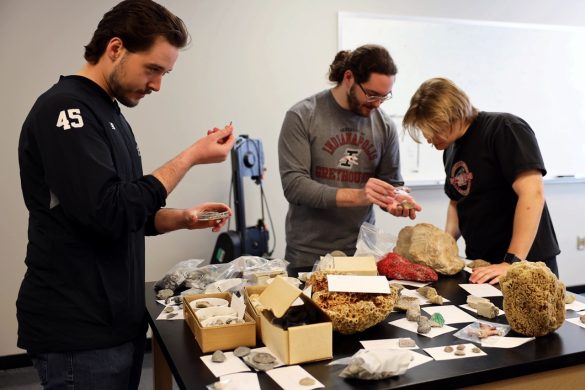
Samantha Peters’ dog, Liam, had to undergo a year of training to be designated a service dog. Liam is able to sense if Peters blood sugar fluctuates and alert her. Photo by Cassie Reverman
Some animal lovers at the University of Indianapolis wish to spend every day with their pets. However, for some students, their pets are necessary to simply go about their day or to be safe. Those individuals rely on their pets as service animals that help them handle a variety of afflictions or situations.
The Americans with Disabilities Act defines a service animal as “an animal that has been individually trained to provide assistance or perform tasks for the benefit of a person with a physical or mental disability which substantially limits one or more of their major life functions.” UIndy also accepts this definition.
Six animals are listed under the UIndy Service Animal policy. UIndy has two categories of enrolled service animals on campus: service dogs and companion/therapy or emotional support animals.
Executive Director for Student Development Debbie Spinney dissected the numbers further, saying that UIndy has more service animals than students may realize.
“[UIndy] has six students that have service animals,” Spinney said. “There are five emotional support animals and one service dog.”
Emotional support animals and service dogs are treated differently based not only on the ADA, but also on UIndy’s specific policies. Although emotional support animals are a form of service animal, Spinney said they are not classified under the same protections or accommodations as service animals.
“Under the Fair Housing Act, [emotional support animals] are allowed to be in public housing,” Spinney said. “They can only be in the personal room. They are not allowed to roam the halls. They are not allowed in public spaces. They are allowed to go out and relieve themselves, but they must be leashed, or tethered somehow at all times. They [also] are not allowed to go to classes.”
Junior digital media studies major Samantha Peters said that she uses her service dog, Liam, to monitor her blood sugar. Peters explained that she purchased Liam after her health took a dangerous turn.
“I have Type I Diabetes, so I started really going downhill in being able to sense when my low blood sugars happened—to the point where I have had a few major lows where I passed out during the night,” Peters said. “He can sense when my blood sugar levels rise or drop, so he is trained to nudge me and eventually jump into my lap if I don’t pay attention to him or get something to eat or drink to get my blood sugars back to normal.”
Peters said that she has always lived off campus, so accommodating Liam inside of a dorm room was never necessary. He does, however, have requirements, such as health insurance and special shoes for handling snow.
Freshman visual communication design major Marissa Orr currently lives in Cory Bretz Hall with her emotional support dog, Angel. Orr is the only residential student with an emotional support animal in the building.
“I think Angel is very helpful,” Orr said. “She really provides me a lot of help throughout the day. If I am stressed out about exams, she can sense [my anxiety] and will jump on my lap.”
Unlike Peters, Orr had to accommodate having a dog in a dorm. She took extra measures to ensure that her roommate did not feel uncomfortable living with a pet.
“I met my roommate six months prior to moving [on campus],” Orr said, “just so that I could get to know her and that I could see if she liked Angel. I did not want her to feel weird or anything. So I took the necessary steps to make sure she felt comfortable.”
Orr also balances taking care of Angel with her class schedule. This time management, she said, is something she is accustomed to.
“[My schedule] hasn’t been too difficult,” Orr said. “Whenever I get a chance, I always take her outside and feed her throughout the day.”
When out with Liam, Peters said that she is grateful when passersby are considerate of her and her service dog rather than asking to pet him.
“I consider him a little bit like a wheelchair, where it’s like he’s here for my health,” Peters said. “You wouldn’t ask to pet my wheelchair or pet my crutches, why would you want to pet my service dog?”
Orr said that she has met others who have expressed interest in the service animal registration process and asked her questions about the topic.
“I’ve realized that I’m the only one [in my building] that has a support animal,” Orr said. “A lot of people have seen they can register for a service animal. They ask me how did I do it. I just tell them that it takes a while to get accustomed to, but it’s worth it in the end.”
The Office of Services for Students with Disabilities provides registration forms and the full-length Service Animal policy on its website at www.uindy.edu/ssd/.









